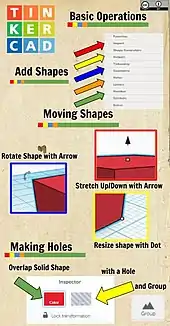Tinkercad
Tinkercad is a free, online 3D modeling program that runs in a web browser, known for its simplicity and ease of use.[1] Since it became available in 2011 it has become a popular platform for creating models for 3D printing as well as an entry-level introduction to constructive solid geometry in schools.[2]
 | |
 | |
| Owner | Autodesk |
|---|---|
| URL | www |
| Commercial | Yes |
| Registration | Yes |
| Launched | 2011 |
| Written in | WEB, JavaScript |
History
Tinkercad was founded as a company in 2010 in the European Union[3] by former Google engineer Kai Backman and his cofounder Mikko Mononen, with a goal to make 3D modeling, especially the design of physical items, accessible to the general public, and allow users to publish their designs under a Creative Commons license.[4] In 2011, the tinkercad.com website was launched as a web-based 3D modeling tool for WebGL-enabled browsers,[5] and in 2012 the company moved its headquarters to San Francisco.[6] By 2012 over 100,000 3D designs had been published by users.[6]
In May 2013, Autodesk announced at a Maker Faire that they would acquire Tinkercad.[7]
In March 2017, Autodesk recommended users of the soon to be retired 123D Sculpt migrate to Tinkercad (or Maya LT).[8] In May, Autodesk discontinued its 123D Circuits (Circuits.io) "Electronics Lab". The program's features were merged into Tinkercad.[9][10][11]
Concept

Tinkercad uses a simplified constructive solid geometry method of constructing models. A design is made up of primitive shapes that are either "solid" or "hole". Combining solids and holes together, new shapes can be created, which in turn can be assigned the property of solid or hole.[4] In addition to the standard library of primitive shapes, a user can create custom shape generators using a built-in JavaScript editor.
Shapes can be imported in three formats: STL and OBJ for 3D, and 2-dimensional SVG shapes for extruding into 3D shapes. Tinkercad exports models in STL or OBJ formats, ready for 3D printing.
Tinkercad also includes a feature to export 3D models to Minecraft Java Edition,[12] and also offers the ability to design structures using Lego bricks.[13]
References
- Herrman, John. "How to Get Started 3D Modeling and Printing". PopularMechanics.com. Hearst Communication. Retrieved 19 May 2013.
- David Gewirtz (15 May 2019). "Everything you need to know about 3D printing and its impact on your business". ZDnet.
- "Tinkercad overview". Crunchbase.
- Timothy Dahl (13 June 2012). "3-D Design for Idiots: An Interview With Tinkercad Founder Kai Backman". Wired.com.
- "Tinkercad uses WebGL, a new 3D web standard". Archived from the original on 14 May 2012.
- Kai Backman (31 August 2012). "Tinkercad largest public repository of solid models".
- Nathan Hurst (18 May 2013). "Autodesk Purchases, Revives 3-D Design App Tinkercad". Wired.com.
- Gewirtz, David. "Do this right now to save your Autodesk 123D designs from shutdown oblivion". ZDNet. Retrieved 28 October 2020.
- Autodesk Circuits is winding down, Autodesk
- Autodesk 123D apps, Autodesk
- Electronics Lab is now Tinkercad Circuits, Autodesk, May 23, 2017
- Brian Heater (14 August 2013). "Tinkercad lets you export 3D designs into Minecraft". Engadget.
- Donald Papp (12 September 2017). "Lego prototyping with Tinkercad's brick mode".